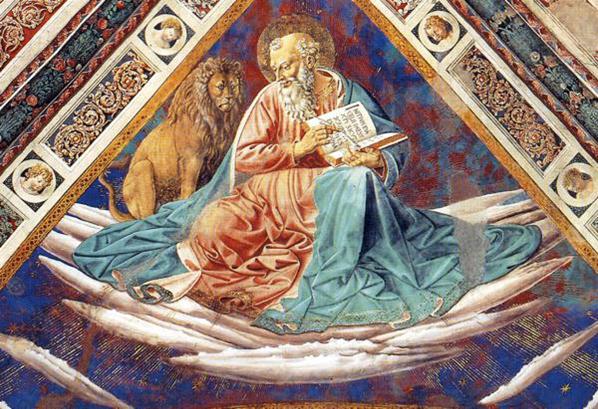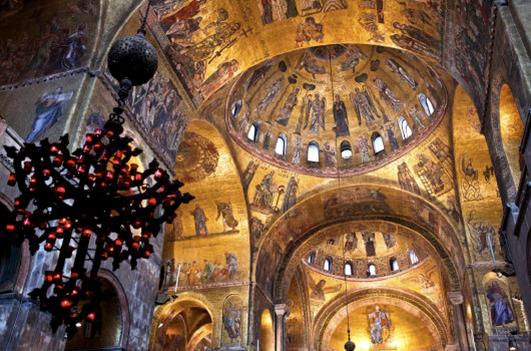

The Liturgical Cycle of Holy Mother Church brings before us today the Lion, who, together with the Man, the Ox, and the Eagle, stands before the throne of God (Ezech. 1: 10). It was on this day that St. Mark ascended from earth to Heaven, radiant with his triple aureole of Evangelist, Apostle and Martyr.
As the preaching made to Israel had its four great representatives—Isaias, Jeremias, Ezechiel, and Daniel—so, likewise, would God have the New Covenant to be embodied in the four Gospels, which were to make known to the world the life and teachings of His Divine Son. The holy Fathers tell us that the Gospels are like the four streams which watered the garden of Eden (Gen. 2: 10). The first of the Evangelists—the first to register the actions and words of our Redeemer—is St. Matthew, whose star will rise in September; the second is St. Mark, whose brightness gladdens us today; the third is St. Luke, whose rays will shine upon us in October; the fourth is St. John, whom we have already seen in Bethlehem, at the crib of our Emmanuel.
 St. Mark was the beloved disciple of St. Peter; he was the brilliant satellite of the sun of the Church. He wrote his Gospel at Rome, under the eyes of the Prince of the Apostles. The Church was already in possession of the history given by St. Matthew; but the faithful of Rome wished their own Apostle to narrate what he had witnessed. St. Peter declined to write it himself, but he bade his disciple take up his pen, and the Holy Ghost guided the hand of the new Evangelist. St. Mark follows the account given by St. Matthew; he abridges it, and yet he occasionally adds a word, or an incident, which plainly proves to us that St. Peter, who had seen and heard all, was his living and venerated authority. One would have almost expected that the new Evangelist would pass over in silence the history of his master's fall, or at least have said as little as possible about it; but no—the Gospel written by St. Mark is more detailed on St. Peter's denial than is that of St. Matthew; and as we read it, we cannot help feeling that the tears elicited by Jesus' look when in the house of Caiphas, were flowing down the Apostle's cheeks as he described the sad event. St. Mark's work being finished, St. Peter examined it and gave it his sanction; the several Churches joyfully received this second account of the mysteries of the world's redemption, and the name of Mark was made known throughout the whole world.
St. Mark was the beloved disciple of St. Peter; he was the brilliant satellite of the sun of the Church. He wrote his Gospel at Rome, under the eyes of the Prince of the Apostles. The Church was already in possession of the history given by St. Matthew; but the faithful of Rome wished their own Apostle to narrate what he had witnessed. St. Peter declined to write it himself, but he bade his disciple take up his pen, and the Holy Ghost guided the hand of the new Evangelist. St. Mark follows the account given by St. Matthew; he abridges it, and yet he occasionally adds a word, or an incident, which plainly proves to us that St. Peter, who had seen and heard all, was his living and venerated authority. One would have almost expected that the new Evangelist would pass over in silence the history of his master's fall, or at least have said as little as possible about it; but no—the Gospel written by St. Mark is more detailed on St. Peter's denial than is that of St. Matthew; and as we read it, we cannot help feeling that the tears elicited by Jesus' look when in the house of Caiphas, were flowing down the Apostle's cheeks as he described the sad event. St. Mark's work being finished, St. Peter examined it and gave it his sanction; the several Churches joyfully received this second account of the mysteries of the world's redemption, and the name of Mark was made known throughout the whole world.
St. Matthew begins his Gospel with the human genealogy of the Son of God, and has thus realized the prophetic type of the Man; St. Mark fulfills that of the Lion, for he commences with the preaching of St. John the Baptist, whose office as precursor of the Messias had been foretold by Isaias, where he spoke of the voice of one crying in the wilderness—as the Lion that makes the desert echo with his roar.
St. Mark, having written his Gospel, was next to labor as an Apostle. St. Peter sent him first to Aquileia, where he founded an important Church; but this was not enough for an Evangelist. When the time designed by God came, and Egypt, the source of countless errors, was to receive the truth, and the haughty and noisy Alexandria was to be raised to the dignity of the second Church of Christendom—the second See of St. Peter, as it were—St. Mark was sent by his master to effect this great work. By his preaching, the word of salvation took root, grew up, and produced fruit in that most infidel of nations; and the authority of St. Peter was thus marked, though in different degrees, in the three great cities of the Empire: Rome, Alexandria, and Antioch. St. Mark may be called the first founder of the monastic life by his instituting, in Alexandria itself, what were called the Therapeutes. To him, also, may be justly attributed the origin of that celebrated Christian school of Alexandria which was so flourishing even in the second century.
But glorious as were these works of St. Peter's disciple, the Evangelist and Apostle St. Mark was also to receive the dignity of Martyr. The success of his preaching excited against him the fury of the idolaters. They were keeping a feast in honor of Serapis; and this gave them an opportunity which they were not likely to lose. They seized St. Mark, treated him most cruelly, and cast him into prison. It was there that our Risen Lord appeared to him during the night, and addressed him in these words, which afterwards formed the slogan on the coat of arms of the Republic of Venice: "Peace be to thee, Mark, My Evangelist!" To which the disciple answered: "Lord!"—for such were his feelings of delight and gratitude that he could say but that one word, as it was with St. Mary Magdalene, when she saw Jesus on the morning of the Resurrection. On the following day St. Mark was put to death by the pagans. He had fulfilled his mission on earth, and Heaven opened to receive the Lion, who was to occupy the place allotted to him near the throne of the Ancient of Days, as shown to the Prophet of Patmos—St. John—in his sublime vision (Apoc. 4).
 In the ninth century the West was enriched with the relics of St. Mark. They were to taken to Venice; and, under the protection of the sacred Lion, there began for that city a long period of glory. Faith in so great a Patron achieved wonders; and from the midst of islets and lagoons there sprang into existence a city of beauty and power. Byzantine art raised up the imposing and gorgeous church, which was the palladium of the Queen of the Seas; and the new Republic stamped its coinage with the Lion of St. Mark. Happy would it have been for Venice had she persevered in her loyalty to Rome and in the ancient severity of her morals.
In the ninth century the West was enriched with the relics of St. Mark. They were to taken to Venice; and, under the protection of the sacred Lion, there began for that city a long period of glory. Faith in so great a Patron achieved wonders; and from the midst of islets and lagoons there sprang into existence a city of beauty and power. Byzantine art raised up the imposing and gorgeous church, which was the palladium of the Queen of the Seas; and the new Republic stamped its coinage with the Lion of St. Mark. Happy would it have been for Venice had she persevered in her loyalty to Rome and in the ancient severity of her morals.
Thou, O St. Mark, art the mystic Lion, who, with the Man, the Ox, and the Eagle, art yoked to the chariot whereon the King of Kings pursues His triumphant course through the earth. Ezechiel, the prophet of the Ancient Testament, and St. John, the prophet of the New Law, saw thee standing nigh the throne of Jehovah. How magnificent is thy glory! Thou art the historian of the Word made Flesh, and thou dost publish to all generations His claims to the love and adoration of mankind. The Church reveres thy writings, and bids us receive them as inspired by the Holy Ghost.
It was thou that, on the glad day of Easter, didst announce to us the Resurrection of Our Lord: pray for us, O holy Evangelist, that this divine mystery may work its effects within us; and that our hearts, like thine own, may be firm in their love of our Risen Jesus, that so we may faithfully follow in Him that new life which He gave us by His Resurrection. Ask Him to give us His peace, as He did to His Apostles when He showed Himself to them in the Cenacle, and as He did to thee when He appeared to thee in thy prison.
Thou wast the beloved disciple of St. Peter; Rome was honored by thy presence: pray for the Church of Rome, against which the wildest storm is now venting its fury. Pray to the Lion of the Tribe of Juda: He seems to sleep; and yet we know that He has but to show Himself, and the victory is gained.
Apostle of Egypt, what has become of thy flourishing Church of Alexandria, Peter's second See, the hallowed scene of thy martyrdom? Its very ruins have perished. The scorching blast of heresy made Egypt a waste, and God, in his anger, let loose upon her the torrent of Islam. Centuries have passed since then, and she is still a slave to error and tyranny: is it to be thus with her till the coming of the Judge? Pray, we beseech thee, for the countries thou didst so zealously evangelize, but whose deserts are now the image of her loss of faith.
And can Venice be forgotten by thee, who art her dearest patron? Obtain for her that she may be purified and return to God, Who has chastised her in His justice.
Contact us: smr@salvemariaregina.info
Visit also: www.marienfried.com